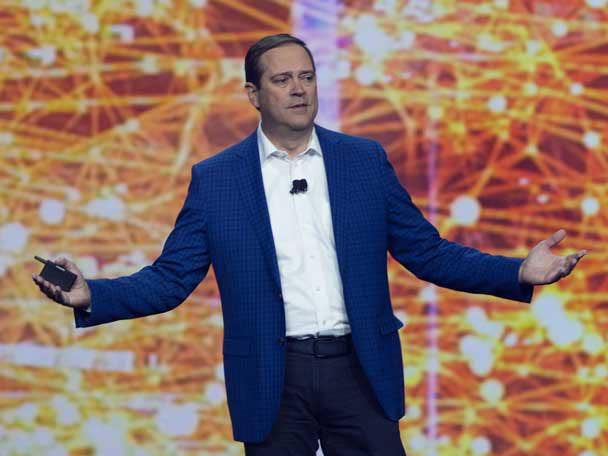Cisco CEO: Product Orders Down As Customers, Partners Focus on Implementation
The tech giant’s once record-breaking backlog has returned to normal, but Cisco execs say that the double-digit product order decline is due to customers and channel partners installing and implementing gear following three quarters of strong product delivery.

Fiscal Q1 2024 marked the strongest first quarter results in Cisco Systems’ history in terms of revenue and profitability, but at the same time, the company’s product orders declined 20 percent year over year.
Cisco Chairman and CEO Chuck Robbins said that the product shortage was largely in the rearview mirror and that the once record-breaking backlog has returned to normal levels. As a result, however, product orders dropped off following three quarters of what Robbins called “exceptionally strong” product delivery.
“Our customers are now focused on installing and implementing these unprecedented levels of products. The bottleneck that we previously saw in the supply chain has now shifted downstream to implementation by our customers and partners … As deliveries rose, the channel inventory we track at our distributors also steadily declined during this time. Simply put, customers are now taking time to onboard and deploy these heightened product deliveries,” Robbins told investors during the company’s fiscal Q1 2024 earnings call on Wednesday evening.
Robbins added that while attending Cisco’s 2023 Partner Summit last week, the company’s largest partners “consistently” brought up the issue of product order declines. He added that the declines are being seen across the large enterprise and service provider spaces, but that ordering for small business and midmarket customers isn’t slowing down.
“In certain parts of our portfolio, we actually can we can see timeframe from shipment of a product until the product begins to connect to the cloud, and what we’re seeing is a one-to-two quarter delay versus what historically you would see when these products get shipped and how long it takes for them to be activated and connected to the Meraki cloud,” he said.
The company said it expects to return to product growth in second half of its fiscal 2024 year.
[Related: Cisco Partner Summit 2023: CEO, Channel Chief Weigh In On Splunk Deal, AI And Channel Culture]
Cisco in the first fiscal quarter of 2024 changed its reporting segment names for its product categories.
Cisco’s Secure, Agile Networks segment, now called “Networking,” includes the core switching and routing businesses, as well as the former Internet for the Future segment, which includes the company’s telecommunications, cloud, and optical networking products. Networking posted impressive revenues of $8.82 billion during the quarter, a 10 percent incline compared to Q1 2023’s result. This quarter, the segment was buoyed by strength in the company’s popular Catalyst and Nexus product lines, as well as strength in campus and data center networking, which offset declines in wireless, said Cisco CFO R. Scott Herren.
Cisco’s product revenues, which was led by the Networking segment, climbed 9 percent and service revenues increased by 4 percent during Q1 2024, said Herren.
Cisco’s End-To-End Security segment, now simply called “Security,” rose 4 percent quarter over quarter with revenues of $1.01 billion, which Herren attributed to strength in the company’s zero trust and threat intelligence and response offerings.
The tech giant during the quarter announced its plans to acquire unified security and observability platform developer Splunk for $28 billion, Cisco’s biggest acquisition to date. Robbins said that the deal, which is expected to close by fiscal Q3 2024, will create a data platform that will enhance customers’ digital resiliency that takes advantage of Cisco’s complementary capabilities in AI, security and observability.
“The combination of Cisco and Splunk also directly supports our strategic objectives around driving higher levels of growth, software capabilities, and [annual recurring revenue] ARR,” Robbins said.
Cisco’s Collaboration segment, which kept its name, has struggled in recent quarters but increased 3 percent year over year to $1.12 billion in revenue compared to Q1 2023, which the company attributed to declines in Meetings that was offset by growth in Calling and Contact Center.
The Observability segment, which was previously referred to as Optimize Apps Experience, grew 21 percent quarter over quarter to $190 million. Observability is an area in which Robbins told CRN earlier this month is a “big opportunity” for the channel.
For Cisco’s fiscal Q1 2024, which ended October 28, revenue climbed 16 percent to $15.20 billion compared to the same period a year ago. Cisco posted non-GAAP earnings per share of $1.11 cents, a 29 percent increase compared to a year ago and non-GAAP net income of $4.5 billion in the first fiscal quarter of the year.
Cisco’s stock plunged 10.68 percent in after-hours trading on Wednesday after the networking giant lowered its full-year sales outlook due to the slowdown in new orders.